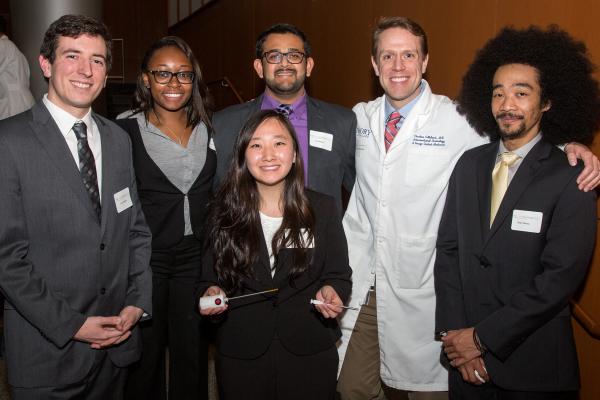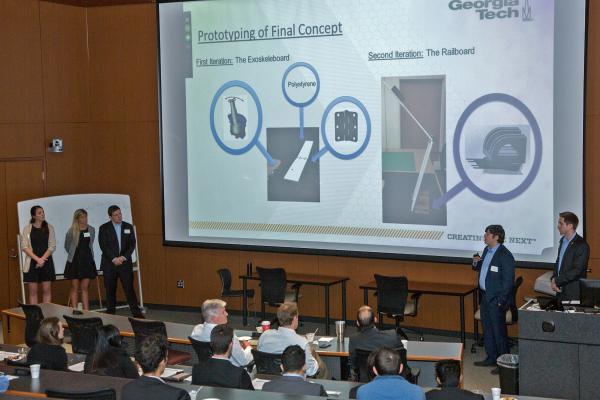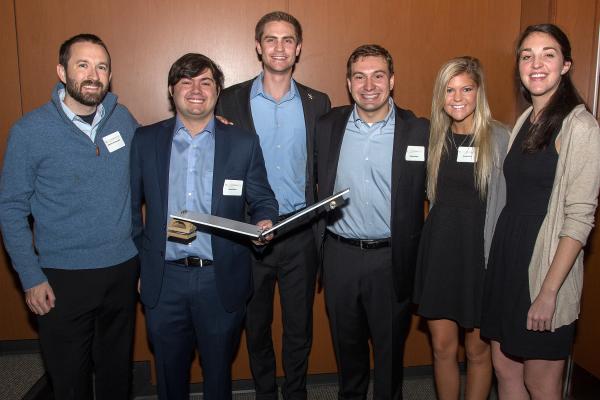This is what collaboration looks like.
Last April, seven interventional radiologists from Emory University’s School of Medicine met with leaders from the Petit Institute for Bioengineering and Bioscience and Coulter Department of Biomedical Engineering (BME) on the Georgia Tech campus.
Basically, the doctors brought a list of clinical needs that they hoped would yield some new ideas for innovative medical devices.
Fast forward to December, the season of giving. Five teams of BME undergraduate students had devoted their fall semester Capstone projects to fulfilling those wishes. A few days before the Fall semester Capstone Design Expo, they presented their projects to the radiologists and some of their colleagues at the Emory School of Medicine.
“As an interventional radiologist, I can say without a doubt that I could see myself using each and every one of these devices when they come to market,” says Zach Bercu, an assistant professor in Emory’s Division of Interventional Radiology and Image-Guided Medicine.
Bercu attended that meeting at the Petit Institute last spring, and helped spearhead the first Emory IR-Georgia Tech Capstone Symposium.
“What’s really unique about these devices, compared to some of the other things we use in interventional radiology, is the cost barriers are so different,” Bercu adds. “We play with a lot of very expensive toys and I’m looking at how, in a single semester, the TraceLess team designed a device that can heat tissue in a second, and they’ve done it with a nine-volt battery. I’m doing the same thing now with a huge generator that needs to be wheeled into a room.”
One by one, each team made their presentations to a room full of potential users, physicians eager for better and more affordable tools of their trade. And one by one, each team received immediate feedback from their live audience.
“These were real doctors, and it’s their professional opinions that matter most because they’re the people who will be using the device,” says Parth Patel, whose team, TraceLess, redesigned a biopsy needle device to minimize tumor seeding.
“When you have everyone in one room giving you feedback and suggestions on what’s great about your product and what’s not so great, that’s invaluable information for us,” adds Josh Bugica of CrossARM, a team of students who designed a device to stabilize a patient’s arm during procedures like CT-scan.
Each team’s project addressed a specific clinical need expressed by Emory interventional radiologists last year at the Petit Institute meeting. In addition to TraceLess and CrossARM, the teams and their objectives were:
• SigTrig: Design a resorbable long-acting reversible contraceptive (LARC), to alleviate what can be a problematic removal process.
• SickleSense: Provide medical staff with the means to quantify the current state of a patient’s blood to properly treat people with sickle cell disease.
• UriCa: Develop a detachable mechanism to allow for a smooth transition from a PCNU catheter to a Double J ureteral stent.
New Partnership
“This was a fantastic beginning to a new partnership,” says James Rains, director of BME Capstone. “What really made it work was matching teams with the right physicians.”
The radiologists-students collaboration just makes perfect sense, Bercu says, since the Coulter Department is a joint department of Emory and Georgia Tech. It was only a matter of time before the interventional radiologists at Emory tapped into the engineering potential at Tech.
“As a field, interventional radiology is ideally suited for innovation,” he says. “It’s a technology driven field and the technology is rapidly changing. So this is a natural partnership. We provide the clinical need, and they provide the creativity and ingenuity and take treatment to the next level.”
Rains and the BME department are collecting more ideas and students and as a new semester takes shape, new teams of BME students are considering their projects for the Spring edition of the Capstone Design Expo (April 25).
“We’d really like to grow this partnership – we have about 200 students ready to work on more projects for next semester,” Rains says.
Growing the partnership, strengthening the ties between Georgia Tech and Emory’s interventional radiologists shouldn’t be a tough sell, according to Harold Solomon, the principal at Georgia Tech VentureLab who helped bring that initial meeting together at the Petit Institute last year.
“This is the beginning of a tight coupling,” Solomon told the audience of physicians and researchers at the symposium in December. “And we’ve got room for more. This biomedical engineering department is ranked number one nationally, this is the pointy-head of the spear, right here, and we’ve got many more talented young people. So bring it.”
READ MORE ABOUT CAPSTONE:
BME Capstone Champs for Fall: CathART
Mechanical Engineering Grabs Fall Spotlight
CONTACT:
Jerry Grillo
Communications Officer II
Parker H. Petit Institute for
Bioengineering and Bioscience
Media Contact
Jerry Grillo
Communications Officer II
Parker H. Petit Institute for
Bioengineering and Bioscience
Keywords
Latest BME News
Jo honored for his impact on science and mentorship
The department rises to the top in biomedical engineering programs for undergraduate education.
Commercialization program in Coulter BME announces project teams who will receive support to get their research to market.
Courses in the Wallace H. Coulter Department of Biomedical Engineering are being reformatted to incorporate AI and machine learning so students are prepared for a data-driven biotech sector.
Influenced by her mother's journey in engineering, Sriya Surapaneni hopes to inspire other young women in the field.
Coulter BME Professor Earns Tenure, Eyes Future of Innovation in Health and Medicine
The grant will fund the development of cutting-edge technology that could detect colorectal cancer through a simple breath test
The surgical support device landed Coulter BME its 4th consecutive win for the College of Engineering competition.










